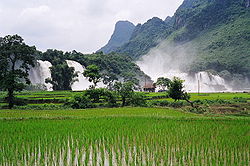Brief Introduction:
Vietnam, officially the Socialist Republic of Vietnam, is the easternmost country on the Indochina Penisula in Southeast Asia. It is bordered by People's Republic of China (PRC)to the north, Laos to the northwest, Cambodia to the southwest, and the South China Sea, referred to as East Sea to the east. With a population of over 89 million, Vietnam is the 13th most populous country in the world.
History:
There are six main periods played the important parts in Vietnamese history, which are Pre -Dynastic era, Dynastic era, French colonization, First Indochina War, Vietnam War, Postwar period.
- Pre -Dynastic era: Archaeologists link the beginnings of Vietnamese civilization to the late Neolithic, Early Bronze Age, Phung Nguyen culture, which was centered in Vĩnh Phúc Province of contemporary Vietnam from about 2000 to 1400 BCE.
- Dynastic era: The range of time in this period is from about 257 BCE to 16th century. The legendary Hồng Bàng Dynasty of the Hùng kings is considered by many Vietnamese as the first Vietnamese state, known as Văn Lang.
- French colonisation: Vietnam's independence was gradually eroded by France—aided by large Catholic collaborator militias—in a series of military conquests from 1859 until 1885 when the entire country became part of French Indochina.
- First Indochina War: A partition of Vietnam, with Ho Chi Minh's Democratic Republic of Vietnam in North Vietnam, and Emperor Bảo Đại's State of Vietnam in the South Vietnam, was not intended to be permanent by the Geneva Accords, and they expressly forbade the interference of third powers.
- Vietnam War: This period of time is from about 1959 to 1975. South Vietnam briefly came under the nominal rule of a Provisional Revolutionary Government while under military occupation by North Vietnam. On 2 July 1976, North and South were merged to form the Socialist Republic of Vietnam.
- Postwar period: At the beginning of this period, the government embarked on a mass campaign of collectivization of farms and factories. This caused an economic collapse and resulted in triple-digit inflation. Reconstruction of the war-ravaged country was slow, and serious humanitarian and economic problems confronted the communist regime. Millions of people fled the country in crudely built boats, creating an international humanitarian crisis. Then, with the development of the reforms, the economy of Vietnam subsequently achieved rapid growth in agriculture and industrial production.
Nature Disasters:
According to the information from the website, the top ten worst nature disasters in Vietnam could be divided as Wind storm, Flood, and Drought.
Retrieved from http://unpan1.un.org/intradoc/groups/public/documents/apcity/unpan009430.pdf on 03/22/11
Government
Government type: Communist state
Capital: Hanoi
Legal system: based on communist legal theory and French civil law system; has not accepted compulsory ICJ jurisdiction.
The Socialist Republic of Vietnam is a single-party state. A new state constitution was approved in April 1992, replacing the 1975 version. The central role of the Communist Party of Vietnam was reasserted in all organs of government, politics and society.
Economy
GDP ( purchasing power parity):
$278.1 billion (2010 est.),country comparison to the world:42;
$260.3 billion (2009 est.); $247.2 billion (2008 est.).
Labor force: Agricultures: 51.8%; Industry: 15.4%; Services:32.7% (April 2009)
Population below poverty line: 12.3% (2009 est.)
Agriculture products:
paddy rice, coffee, rubber, cotton, tea, pepper, soybeans, cashews, sugar cane, peanuts, bananas; poultry; fish, seafood.
Industries: food processing, garments, shoes, machine-building; mining, coal, steel; cement, chemical fertilizer, glass, tires, oil, paper.
Exports:
Commodities: crude oil, marine products, rice, coffee, rubber, tea, garments, shoes.
Imports:
$81.73 billion (2010 est.)Country comparison to the world: 35; $65.4 billion (2009 est.)
Commodities: machinery and equipment, petroleum products, fertilizer, steel products, raw cotton, grain, cement, motorcycles.
Vietnam Food
Vietnamese cuisine uses very little oil and many vegetables. The main dishes are often based on rice, soy sauce, and fish sauce. Its characteristic flavors are sweet (sugar), spicy (serrano peppers), sour (lime), nuoc mam (fish sauce), and flavored by a variety of mint and basil.
A typical meal for the average Vietnamese family would include:
l Meat, fish or seafood (grilled, boiled, steamed, stewed or stir fried with vegetables)
l Prepared fish sauce and/or soy sauce for dipping, to which garlic, chili, ginger or lime juice are sometimes added according to taste.
Popular Vietnam Dishes:
Noodle dishes, Noodle soups, Soup and Chao (congees), Rice dishes, Sticky rice dishes, Dumplings and pancakes, Wraps and rolls, Sandwiches and pastries, Meat dishes, Seafood dishes.
Pictures Area
The map of Vietman
Picture is from (https://www.cia.gov/library/publications/the-world-factbook/maps/maptemplate_vm.html)
The Flag of Vietnam
Ban Gioc Waterfalls in Northern Vietnam

A Vietnamese woman wearing a kind of traditional cloth
Picture is from
Noodle soup
(Picture is from http://en.wikipedia.org/wiki/Vietnamese_cuisine)
Sticky rice dishes
(Picture is from http://en.wikipedia.org/wiki/Vietnamese_cuisine)
Summer roll( spring roll) with sources
(Picture is from http://en.wikipedia.org/wiki/Vietnamese_cuisine)
References:
Thị Chơi Triệu, Marcel Isaak, (1998) The Food of Vietnam: Authentic Recipes from the Heart of Indochina, Tuttle Publishing <http://books.google.com/books?id=23whNlie230C>
CIA -the world face book, March 1st 2011,< https://www.cia.gov/library/publications/the-world-factbook/geos/vm.html>
Wikipedia -Vietnam, March 1st 2011, http://en.wikipedia.org/wiki/Vietnam
"EM-DAT: The OFDA/CRED International Disaster Database, universite catholique de Louvain, Brussels, belgium" <http://www.cred.be/emdat/intro.htm>






No comments:
Post a Comment